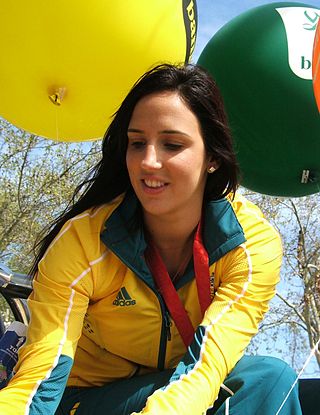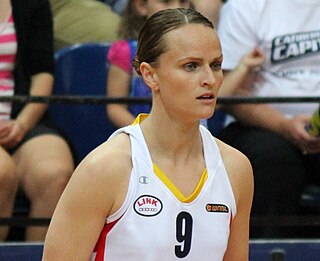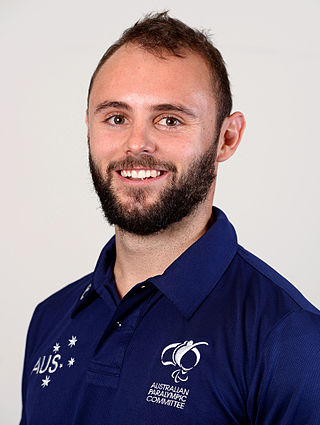Related Research Articles

The Australian Institute of Sport (AIS) is a high performance sports training institution in Australia. The Institute's 66-hectare (163-acre) headquarters were opened in 1981 and are situated in the northern suburb of Bruce, Canberra. The AIS is a division of the Australian Sports Commission (ASC), part of the Australian Government under the Department of Health and Aged Care.
Petria Ann Thomas, is an Australian swimmer and Olympic gold medallist and a winner of 15 national titles. She was born in Lismore, New South Wales, and grew up in the nearby town of Mullumbimby.

Belinda Snell is an Australian women's basketball player. She is a member of the Australia women's national basketball team, and has won two silver medals in basketball at the 2004 & 2008 Summer Olympics, a bronze medal at the 2012 Summer Olympics, a gold medal at the 2006 Commonwealth Games, a gold medal at the 2018 Commonwealth Games, a gold medal at the 2006 World Championships, and a bronze medal at the 2014 World Championships.
Adam Robert Pine is a former competitive swimmer and current sports administrator. He has represented his country in numerous international competitions, earning several medals and setting national and commonwealth records. After retiring from competitive swimming, Pine transitioned into a career as a sports administrator, where he has made a significant impact in developing and promoting the sport in his community. He is respected for his dedication and passion for sports, as well as his ability to effectively lead teams and manage sports organisations. Pine specialised as a sprint freestyle and butterfly swimmer. He was an Australian Institute of Sport (AIS) scholarship holder and national team member from 1993 to 2009 and has the longest tenure on the Australian Swim Team.

Laura Hodges is an Australian female professional basketball player, having played in Australia's Women's National Basketball League (WNBL), Europe, and the WNBA. She currently plays for the Adelaide Lightning in the WNBL.
Ronald George "Ron" Harvey, is a former senior Australian public servant and sport administrator. He was the third director of the Australian Institute of Sport, serving in the role from 1987 until 1989.

Jennifer (Jennie) Screen is an Australian basketball player. She has played for the Australian Institute of Sport, the Adelaide Fellas and the Adelaide Lightning in Australia's WNBL, and has spent time playing professionally for Parma in Italy. As a member of the Australia women's national basketball team, she has won a gold medal at the 2006 Commonwealth Games, a silver medal at the 2008 Summer Olympics and a bronze medal at the 2012 Summer Olympics.

Evan George O'Hanlon, is an Australian Paralympic athlete, who competes mainly in category T38 sprint events. He has won five gold medals at two Paralympic Games – 2008 Beijing and 2012 London. He also represented Australia at the 2016 Rio Paralympics and 2020 Tokyo Paralympics, winning a silver medal and a bronze medal respectively. In winning the bronze medal in the Men's 100m T38 at the 2019 World Para Athletics Championships in Dubai, O'Hanlon became Australia's most successful male athlete with a disability. His bronze medal took him to 12 medals in five world championships – one more than four-time Paralympian Neil Fuller.
Richard David Telford AM is a former Australian rules footballer who played for Collingwood and Fitzroy in the Victorian Football League (VFL) during the 1960s, although he mainly played reserves. He went on to become as a leading Australian sport scientist and distance running coach. He was the first sport scientist employed by the Australian Institute of Sport (AIS).

Christopher John Nunn, OAM is an Australian athletics coach. He was the head coach of the Australian athletics team at the 2000 Sydney Paralympics.
Matthew "Matt" Favier is an Australian sport administrator. He was appointed the eighth Director of the Australian Institute of Sport in December 2011.

Jamie Dwyer is an Australian field hockey player. He currently plays for YMCC Coastal City Hockey Club in the Melville Toyota League in Perth, Western Australia. He also played for the Queensland Blades in the Australian Hockey League. He debuted for Australia as a junior player in 1995, and for the senior side in 2001. He has played over 350 matches for Australia and scored over 220 goals. He has represented Australia at the 2004 Summer Olympics where he won a gold medal and the 2008 Summer Olympics and 2012 Summer Olympics where Australia won bronze medals. He has also represented Australia at the 2006 Commonwealth Games where he won a gold medal and the 2010 Commonwealth Games where he also won gold. He has won silver medals at the 2002 Men's Hockey World Cup and the 2006 Men's Hockey World Cup. He won a gold medal at the 2010 Men's Hockey World Cup and the 2014 Men's Hockey World Cup. He is widely regarded as one of the greatest players to ever play the game.

Scott Peter Reardon, is an Australian Paralympic leg amputee sprinter and water skier. He won water skiing world championships in 2007 and 2009. He represented Australia at the 2012 Summer Paralympics in athletics, winning a silver medal in the Men's 100 m T42. At the 2016 Rio Paralympics, he went one placing better to win the gold medal. Reardon has won the Men's 100 m T42 in three consecutive World Para Athletics Championships, from 2013 to 2017. He competed at the 2020 Tokyo Paralympics, his third games.

John Bloomfield was an Australian sport and sport science academic and author. Bloomfield played a crucial role in the development of the Australian high performance sport system between 1973 and 1989, particularly in relation to the Australian Institute of Sport and the Australian Sports Commission. While active in the above, he lectured and conducted research at the University of Western Australia and, from time to time, in North America and Eastern and Western Europe.
Allan Geoffrey Hahn OAM is a leading Australian sports scientist. Between 1984 and 2011, he made a significant contribution to the Australian Institute of Sport (AIS) in the areas of sports physiology and technology. In September 2011, he was appointed Emeritus Professor at the AIS.
The organisation of sport in Australia has been largely determined by its Federal system of government – Australian Government and six states and two territories governments and local governments. All three levels play an important role in terms of funding, policies and facilities. Each major sport is managed by a national sports organisation, with state counterparts that manage community sporting clubs. Umbrella or peak organisations represent the interests of sports organisations or particular sport issues. Education sector plays a small role through universities and schools. Private sector's involvement is extensive in professional sport through facilities, club ownership and finance/sponsorship.
Bruce Robert Mason OAM is a leading Australian sports scientist in the field of biomechanics. Between 1982 and 2014, he made a significant contribution to the Australian Institute of Sport (AIS) in the area of biomechanics, particularly in the sport of swimming.
John Alfred Daly OAM was an Australian academic physical educator, sports historian and Australian Olympic athletics coach.
Louise Mary Burke, is an Australian sports dietitian, academic and author. She was the head of sports nutrition at the Australian Institute of Sport (AIS) throughout its existence from 1990 to 2018 and in 2018 was appointed Chief of AIS Nutrition Strategy. Since 2014, she holds the chair in sports nutrition in the Mary MacKillop Institute for Health Research, Australian Catholic University.

The Australasian College of Sport and Exercise Physicians (ACSEP) is a not-for-profit professional organisation responsible for training, educating, and representing over 350 doctors in Australia and New Zealand. These doctors practise medicine in the specialty of sport and exercise medicine (SEM). The ACSEP is the smallest of the 15 recognised specialist medical Colleges in Australia with approximately 260 Fellows and Registrars in 2020.
References
- 1 2 3 "Peter Fricker". It's An Honour Website. Archived from the original on 15 May 2019. Retrieved 10 June 2012.
- 1 2 3 4 5 6 7 8 9 10 11 12 Who's who in Australia. Melbourne: Crown Content. 2010. p. 798.
- ↑ "Lyall Fricker AM FACE". Australian College of Educators website. Archived from the original on 22 April 2012. Retrieved 10 June 2012.
- ↑ "Lyall Fricker interviewed by Tony Ryan in the Conversations with Australian educators oral history project". National Library of Australian Catalogue. Archived from the original on 27 March 2012. Retrieved 10 June 2012.
- ↑ "Getting in touch with all our pasts". The Canberra Times. 3 February 2012. Retrieved 10 June 2012.
- 1 2 3 4 "Profile Peter Fricker". The Age. 11 August 2011. Retrieved 10 June 2012.
- 1 2 "Minister thanks Peter Fricker for service to sport". Australian Sports Commission News, 8 August 2011. Archived from the original on 30 April 2012. Retrieved 10 June 2012.
- 1 2 3 "Award of the Order of Merit" (PDF). Australian Olympic Committee Annual General Meeting Agenda, 5 May 2012. Retrieved 10 June 2012.
- ↑ "Peter Fricker, OAM, MBBS (UNSW), FACSP, FRACP (Hon.)". Professionals Against Doping in Sports Website. Archived from the original on 15 April 2013. Retrieved 10 June 2012.
- ↑ "Peter Fricker". Penguin Australia Website. Retrieved 10 June 2012.
- ↑ "Smart 100 innovators make Australia the clever country". Industry Search Website. Retrieved 10 June 2012.
- ↑ "AIS Director Peter Fricker honoured for services to sports medicine". Australian Sports Commission News, 27 October 2009. Archived from the original on 24 March 2012. Retrieved 10 June 2012.